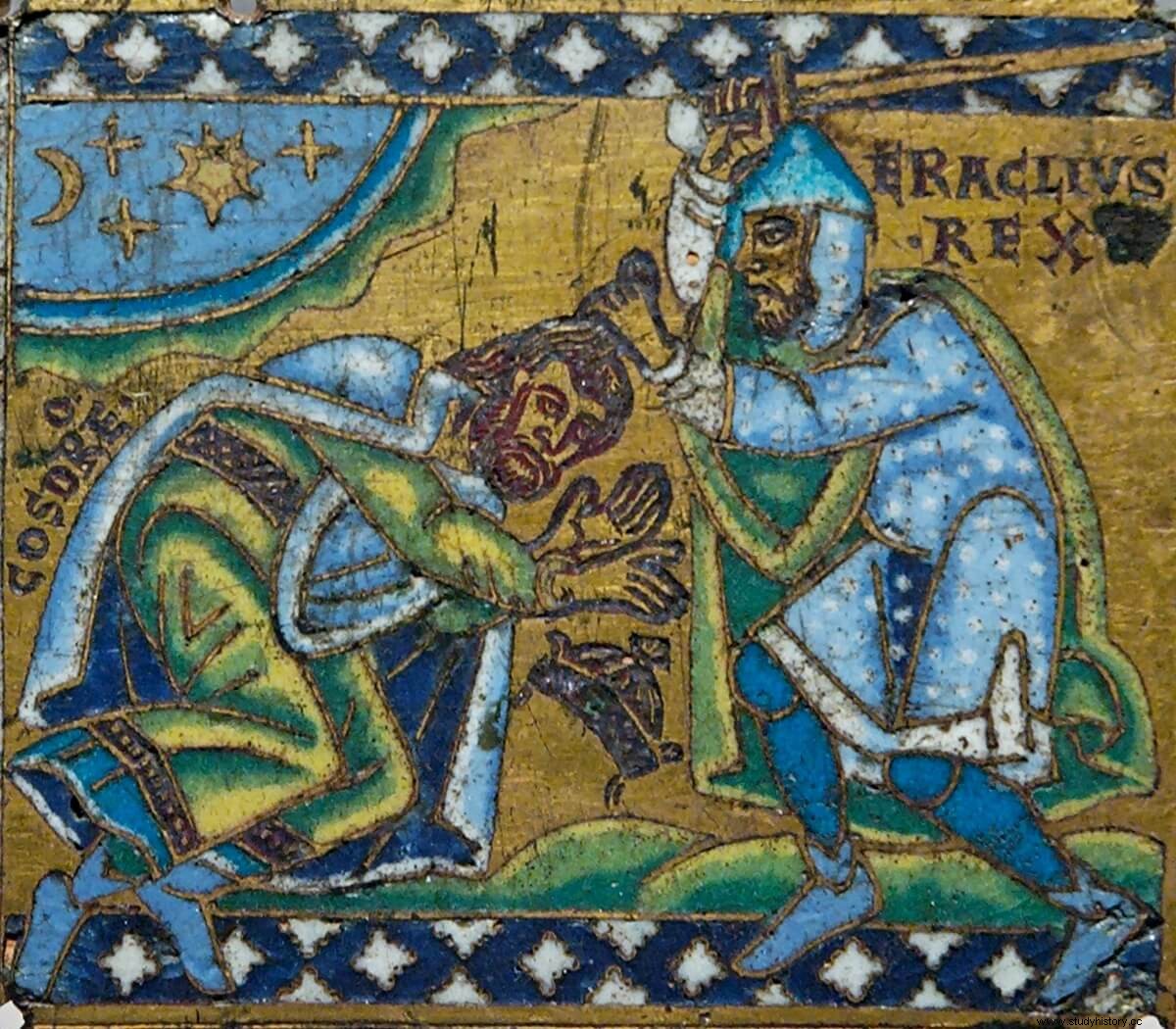
Now, the Muslim jihad and the Christian crusade They were undoubtedly two maximum exponents of hybridization between religion and war. Interestingly, in the consolidation of the idea of holy war In both spaces of civilization, the figure of an emperor appears, Heraclius, the last Roman sovereign to exercise his authority from one end of the Mediterranean to the other and whose victories are even the subject of one of the prophecies contained in the Koran (30,1 -4), and this at the same time that he was perceived by the Christians of his time as a kind of messianic emperor whose battles and victories announced the imminent second parousia of Jesus Christ and the consummation of time, leaving in the medieval European conscience the idea that he had been the forerunner of the crusaders and the greatest exponent of a new type of heroic model that already preluded the features of what centuries later would be known as "Christian chivalry"
And it is that Heraclius, who came to the Constantinopolitan throne at a time when the Empire was on the verge of collapse, had to use all available resources to galvanize his soldiers and subjects and successfully face the “deluge of fire and blood” that devastated Romania. That "deluge" was none other than the great Roman-Persian war of 603-628, undoubtedly one of the most brutal and decisive conflicts in universal history, and not only because it was fought on three continents and involved the two most powerful empires. of his time, the Roman and the Persian, but because it was the necessary and indispensable prelude to the rise of Islam and its future and immediate expansion.
Between 603 and 608 the Roman Empire was subjected to a maelstrom of purges, religious struggles, social upheavals and civil wars that alone would have already undermined the foundations of many less powerful empires. But to all that was added the war with the other superpower of the ancient world:Persia. Khosroes II Parviz the Victorious he did not miss the opportunity and sent the sphabad, his generals, to tear down the fortified borders of Romania. Shahrbaraz, "the angry boar" of Persia, and Shain were two spahbad especially diligent in this task and by 609 the Sassanian armies were already penetrating Cappadocia and Syria.
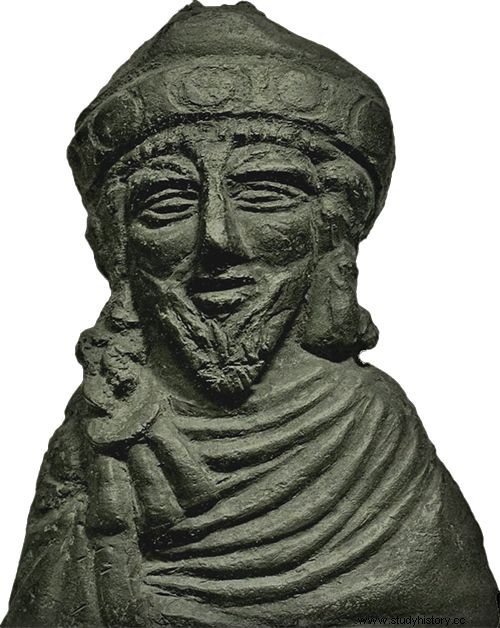
Meanwhile, the exarch of Carthage, the maxim military and civil authority of Roman Africa, Heraclius the Elder, one of the few Roman generals who had escaped the bloody purges of Emperor Phocas (602-610), took up arms and sent his son, Heraclius, in command of a maritime expedition that was to take Constantinople. This expedition was already covered with heroic and chivalrous overtones that the sources, not only the Byzantine ones, but also the Western ones, collect with relish. And it is that Heraclius advanced with a fleet on which the blue and purple banner of "the Virgin as the throne of Christ" waved and in addition to overthrowing the tyrannical Focas , he had his own personal mission:to rescue his fiancée, the beautiful Fabia, a young African noblewoman held hostage by the unpredictable and brutal emperor.
War rages
So the story of Heraclius already began as an adventure worthy of a good medieval knight and the sources of the 7th and 8th centuries reveled in it. To attest to such a heroic undertaking, it is enough to read the magnificent poems that George of Pisidia, friend and poet of Heraclius, composed in those days.
Heraclius achieved his goals in a single day, October 4, 610:he stormed Constantinople, freed his betrothed, executed the usurper Phocas – an emperor who would not have been out of place in a meeting with Caligula, Nero, Domitian and Commodus–, he was crowned and married Fabia, who adopted the imperial name of Eudocia (Theophanes 6102, 298-300; George of Pisidia, In Heraclium ex Africa redeuntem ).
Not a bad ending to a story in a future book of chivalry. But the real story is always more complex. While Heraclius sailed to Constantinople and his cousin Nicetas occupied Egypt, the Sassanid armies roamed wide of him.
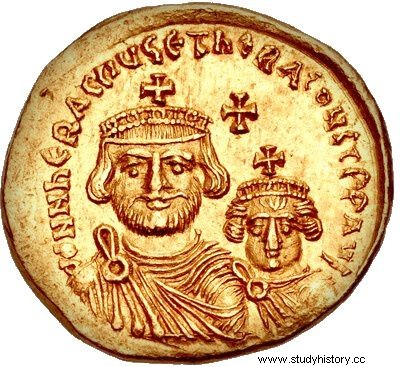
They kept doing it and not just them. The only good thing that the happily executed Focas had achieved was holding the Danubian border against Avars and Slavs . His death spelled the end of the treaty with the Avar hagan, and in 611 hordes of Avar horsemen and savage war bands of Slavic tribes spilled over the Balkans. They would soon reach the Peloponnese and the outskirts of Constantinople.
War raged. Antioch was taken by the Persians and the Roman troops, led by Heraclius, were defeated in two hard-fought battles at Antioch and in the Gorges of the Taurus. A third Roman army, led by Nicetas, was similarly defeated in Syria, and Damascus was sacked in 613.
Jerusalem was besieged. The city experienced apocalyptic scenes . The Persians had won the support of the Jewish population of Syria and Palestine, and when they stormed Jerusalem on May 20, 614, long-repressed hatreds erupted into indiscriminate slaughter. Some 35,000 people perished on the streets of the Holy City and another 57,000 were deported to Mesopotamia. While such atrocities were taking place, Persian warriors were busily searching for the relics of Christ and all the sacred objects associated with Christianity and Judaism (Antiochus Strategos, On the Taking of Jerusalem ).
Heraclius, Crusader Emperor
Relics… Yes, they had become important in that imperial war. The wife of the Shahansha of Persia, the legendary Shirin, was a Monophysite Christian and her imperial husband, Chosroes II, wanted to use the ascendancy of his Banbishnan Banbishn, that is, his "Queen of Queens," over the Christian communities of Romania. to attract their favor once subjected to their new Persian Empire. That's why she wanted to get hold of the relics.
Every symbol is power. The emotions and ideas that are embodied in a symbol act powerfully as catalysts and that is why the control of symbols is so important. Whoever possessed the relics of Christ would have a powerful argument for spreading the idea that the Christian God supported his dominion. That is why the Vera Cruz , the most precious relic of all, was taken from Jerusalem to Ctesiphon, the Persian capital, and honored there.
Other relics followed suit and it is likely, in my opinion, that it was then that the trail of the Menorah was truly lost. , the candelabrum of the seven arms that in 71 d. C. Titus led Rome in triumph and that Genseric, king of the Vandals, stole from Rome in 455 taking it to Carthage, so that Belisarius, already in 534, seized it in turn by sending it to Constantinople, where it was exposed in the hippodrome before an astonished Justinian who, following the advice of a notable Jew, decided that this powerful sacred object that had brought such misfortune to Jerusalem, Babylon, Rome and Carthage, would do well to return to old Zion and away from Constantinople ( Procopius, History of wars IV.9.5-7).
Serve the previous story so that we are aware of the value that sacred relics had in the ancient and medieval world. Heraclius was well aware of this and knew how to use them to a greater and better degree than anyone before or after him.
The True Cross and the Cristopoliá, the "Image not painted by human hands", this is, and almost certainly, our Shroud of Turin , are intimately associated with Heraclius and his campaigns and to such an extent that a "Cycle of the True Cross" developed throughout Europe, the "Golden Legend" in which Heraclius and his struggle to recover the True Cross was the center motif. The stained glass windows of the Saint Chapelle in Paris, the frescoes by Piero della Francesca in Santa Croce in Florence and countless other works of art, scattered from Scotland to Spain and from Russia to Portugal, are proof of this.
But Heraclius' association with relics goes far beyond the True Cross and the Shroud. Heraclius came to see himself as a "new Noah," as the founder of a new humanity, and this led him to seize the relics of Noah that were kept in Naxcawan, an Armenian city under Persian rule, in the spring-summer of 623. storming the city walls, Heraclius secured possession of the "axe of Noah" and the olive branch that the biblical dove carried in its beak back to the Ark and sent the precious relics to Constantinople (Sebeos 81; Ananias de Shirak, Geography , p. 60).
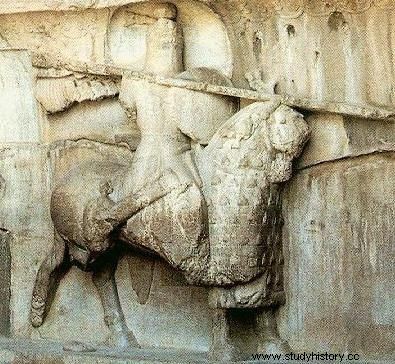
It was not only about seizing relics of his own, but also about destroying the symbols and sacred objects of the enemy. That same summer, Heraclius put the Sassanid army led by Khosroes II to flight and took the most sacred fire temple:Adharguschnasp, “the fire temple of the warriors”. Heraclius extinguished the sacred fire, polluted the waters of the equally sacred lake that guarded the formidable walls of the temple-fortress, seized the treasures and relics that were guarded there and destroyed the Takh i Taqdis, the "astronomical throne" of Chosroes, a of the wonders of the ancient world, whose destruction resounded loudly and was represented again and again in medieval art and carried into a multitude of narratives and legends from East and West (Theophanes, 6114,308-309; Patriarch Nicephorus, Brief History 12).
The amazing thing about Heraclius is that unlike other emperors and kings, his actions are what project his political propaganda and not the other way around. The emperor carries out "heroic" deeds that are later sung by his poet, George of Pisidia, and that spread throughout the Mediterranean and the Middle East, adopting legendary overtones as they expanded.
Relics and battles
That would perfectly sum up Heraclius' reign between 622 and 628. At Easter 622 he stood before the last great Roman army armed as just another Byzantine knight, but bearing the “Image not painted by human hand” (George of Pisidia, De expeditio persica I, 135-145 and II, 80-120). That same summer, and not winter as some foolishly claim, he led his host of forty thousand soldiers into the mountains of Pontus. It was an epic campaign. He was up against Persia's greatest general, Sharbaraz, and defeated him through wit and skill. On August 6, 622, the day of the Lord's transfiguration, a major battle was fought in which Heraclius knocked out the Persian army. A few days before, Heraclius had exposed himself personally to force the Persians to abandon their positions:As the Persians stayed on the hills in a defensive attitude and did not go down to the plain to engage in combat, Heraclius formed his army in line of battle and then he arranged for a banquet to be prepared for him, placing the table between his hosts and the astonished enemy troops, who watched as the Roman emperor was left alone with his feast and ate with disdainful parsimony, throwing the bones at them and defying them. They couldn't take the offense and charged at him. Heraclius did not flinch. His soldiers came and they fought viciously around the emperor, the Persians being repulsed with heavy casualties (George of Pisidia, De expeditio persica III,40-80).
This “heroic” attitude of Heraclius it was key and well thought out. Roman armies had been defeated time and time again by the Persians from 603 to 621 and morale and confidence had been virtually destroyed. Heraclius knew that only personal example would restore them. In addition, already from the days of Belisarius, throughout the Empire, but very particularly among the Armenians who made up a considerable part of the troops of the Roman armies of the sixth and seventh centuries, behavior formulas were being developed that already preluded the values chivalresque that curdled in the medieval world. Heraclius knew that to win that war it was not enough to be an emperor, but he also had to be a hero.
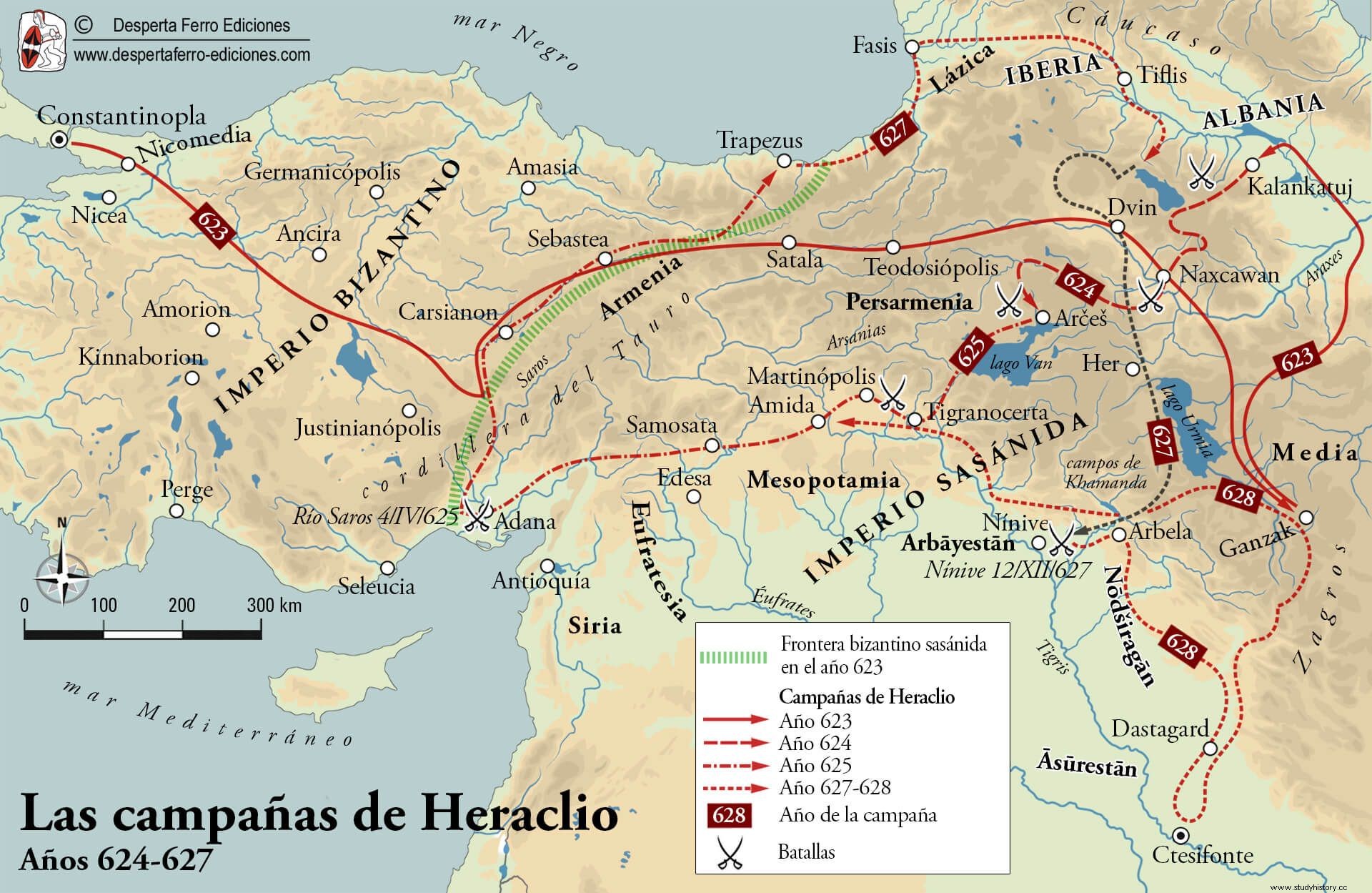
And he was. He was personally involved in battle and was wounded several times. In 625, on April 4 and over the Saros river bridge , today in Adana, Turkey, he knew how to put an end to the disbandment of his troops before the Persian attack, planting himself on the bridge and fighting on it with determination until a gigantic Persian champion met him in single combat. Heraclius defeated him and threw him into the river, causing his troops to reach the ecstasy of battle and resume the fight with wild enthusiasm, thus saving the day (Theophanes 6116, 314).
For us all this is difficult to understand. The ancient and medieval warfare it moves in parameters that escape us. We have to remember that the hand-to-hand confrontation with bladed weapons was something extremely bloody and terrible. Approaching a spear or sword in hand to a wall of enemies that await you on foot, brandishing their blades, requires enormous courage and discipline. That is why the personal example, the heroic actions, were so necessary. It is this that explains the duels before the battles. The duel was a necessary rite to inflame one's courage and undermine that of the enemy. This is why ancient and medieval armies had champions and why most battles began with challenges and insults. It was about gathering value and that is not easy. Similarly, symbols, relics, acts of faith, etc. They played a primary role, as well as harangues and other more profane resources such as alcohol and barrack jokes.
A whole system of relationship with the sacred was developed when making military decisions or raising the morale of men. One of those formulas or techniques, also used by Heraclius, was that of "biblical divination". In desperate situations, she was used to make decisions and endow them with divine force or sanction. Surrounded by several Persian armies and with winter closing in on them hundreds of miles from their base, the Roman soldiers were beginning to despair. Heraclius formed his men and appeared before them to tell them that they were putting themselves in God's hands. Then he opened the Gospels and put his finger on a random passage and thus got "God's answer" to the general question of what to do:they would spend the winter in Caucasian Albania, present-day Azerbaijan (Theophanes, 6114, 308). Regardless of the theatricality and the manipulation of it, what matters is Heraclius' ability and the ascendancy that this type of gesture had over the soldiers.
The “biblical equating”, if I may use the expression, also played a great role in Heraclius' holy war. In 624, in the Valley of the Araxes , he was again cornered by three Persian armies. He formed his troops in battle line to face two of them who were hot on his heels and arranged a small surprise by hiding part of his cavalry on a wooded hill. It was about defeating those two Persian armies that were approaching them before the third one appeared. It was a desperate situation in the extreme. The Caucasian allies of the emperor, the Christian tribes of the region were deserting and the Persians had a vast superiority in numbers.
Faced with such a situation, Heraclius ordered to stop and face the approaching enemy. Showing himself to his men in all his warrior glory, he rode up and down their battle line as the Persians also lined up for the coming fight. The emperor kept shouting at his men:"God willing, one will put thousands to flight!" (Deuteronomy 32,30). It was a free quote that paraphrased a passage from the book of Deuteronomy, and with it Heraclius reinforced another of the symbolic associations that he continually made between his troops and the “Sacred History”:They, his army, were the “new people of Israel.” They were a sacred army, a holy people, and he, their emperor, was the "new Moses" willing to defeat the "new pharaoh", Khosroes II (George of Pisidia, Bellum Avaricum I,495-500 and George of Pisidia, De expeditio persica I,135-149, among many others and Theophanes 6115,311).
The battle was hard. But at the decisive moment, the cavalry reserve that Heraclius had placed on the wooded hill emerged and the Persian front line collapsed. Just in time, the Persian Third Army was approaching at full speed. Heraclius, without pause between one battle and another, reordered his host and led it in a marching column towards the enemy. Both armies collided with each other and the Roman forces fought their second battle on that memorable day and won their second victory.
Heraclius's campaigns are on a par, strategically and tactically speaking, with those of a Scipio, a Caesar or an Alexander. With them he was compared in his time and it is fair that it be so even though today Heraclius sleeps in unjust oblivion (George of Pisidia, Heraclias I,95-100, Heraclias I, 110-115).
For years he fought for the most difficult territories in what are now eastern Turkey, Armenia, Georgia, Azerbaijan, the Russian autonomous republic of Dagestan, Iran and Iraq, often in regions still inaccessible today located at three thousand meters of altitude and almost always harassed by forces far superior to theirs and living on the ground. In conditions like this, either you lead your men heroically, as Alexander the Great did, or you are defeated.
Heraclius was not defeated. He knew that he had to be a hero and that the gods/God must/must be with you. Alexander followed in the footsteps of Dionysus and emulated the exploits of Achilles, Heraclius showed himself as a new David, as a new Daniel, Moses or Noah, but also as a new Hercules, a new Jason or Perseus and as a new Alexander, Scipio or Constantine. Everything, the Old Testament and the New, the Iliad or the Argonautica, could be used if it achieved the morale and conviction that lead to victory (Georges of Pisidia, De expeditio persica III,350-355, Heraclias II,15-20, and George of Pisidia, In restitutionem Sanctae Crucis 60-65)
The recovery of Vera Cruz
But this was a holy war and its main object was to recover the True Cross. Not because it was what most urged Heraclius, undoubtedly more concerned about the revenues of Syria, Egypt or Palestine, but because he had understood that the symbolic plane of war was as vital as the purely military or economic one.
December 12, 627, on the Nineveh plains , on the outskirts of present-day Mosul, Heraclius led his army into an epic battle. Closely followed by a Sassanian army, he took advantage of the cold morning's thick fog to halt his advance, turn and form into battle line. As the mist cleared, the Persians following the Roman army found themselves in a lightning formation. Trying to break the astonishment that gripped the warriors of him, Razates, the Persian sphabad, challenged the Roman emperor to personal combat. Heraclius accepted the challenge and struck down his opponent not before being wounded. There was no time for medical care. The battle broke out and thundered around the emperor, who "like a magnetic stone attracted enemies." The Dailamite infantry, elite Persian heavy infantry recruited from the tough hillmen of northern Persia, were particularly focused on trying to take Heraclius's life. He had to fight fiercely to break through and his warhorse, Dorcon, received several wounds despite being clad in powerful equine armor (Theophanes:6118, 317-321; Agapios:464-465; Sebeos, 83-84; al-Tabari:V, 1005-1006, pp. 322-324; Patriarch Nicephorus, 14; George of Pisidia II:Acroatis, fragments; Paschal Chronicle , 729-734).
In the evening, Persia's warrior elite lay upon the battlefield. It was a massacre that, however, did not break the discipline of the Sassanid army that remained on the field watching over their dead and that only with the dawn withdrew through the hills.
After plundering the great Persian palaces and feigning an attack on his enemy's capital, Heraclius retreated north, plundering and ravaging the Persian land, wintering at Ganzak in the north of today's Iran.
His mortal enemy, Chosroes II, did not survive the winter . His prestige was ruined and soon the conspiracies revolved around him. One of them, led by his son, triumphed and led to his death. The new Persian sovereign, Khavad II, offered peace to Heraclius and with it the restitution of the True Cross (Chronicle of Khuzistan 236-237).
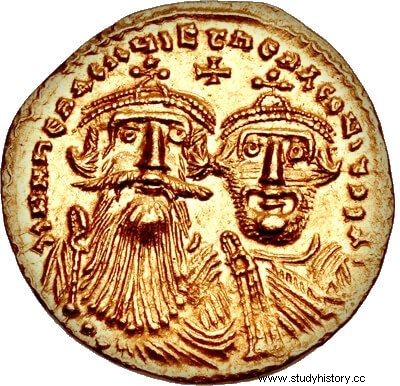
It was the end of a twenty-five year war that had caused hundreds of thousands of deaths and the ruin of two empires and that forever changed the perception of war and religion.
As final proof of this, while marching back to Constantinople, Heraclius went out of his way to ascend to the “true Ararat” . Indeed, today we look at the Ararat that stands on the border between Turkey, Armenia and Iran and devour the documentaries that tell us about the old biblical story of Noah and his Ark and the alleged evidence of its historical reality. The truth is that, although the Armenian tradition linked the current Ararat with Noah since the 5th century of our era, the majority of Christians and Jews of Antiquity and the High Middle Ages followed a much older tradition and believed that the true mount Ararat was further south. That mount is the current Al-Judi or Al-Cudi, on the border between Iraq and Turkey, which today remains the holy mountain of Noah for millions of Muslims and Jews.
In the time of Heraclius, that mount was Ararat and he ascended to it. His idea was to vindicate himself, once again, as a new Noah. As the founder of a new humanity. We do not know what ritual he carried out on the summit, but we do know that during it he turned to the four cardinal points and that when he came down from the mountain he did so with a supposed fragment of Noah's Ark. Part of that "sacred log" was deposited in a monastery founded at the base of the mountain. Not far from it, the caliph Omar would order years later to build a mosque in honor of the patriarch, and a synagogue, that of Esdras, visited in the 12th century by the Spanish traveler Benjamín de Tudela, completed the religious buildings that bordered the mountain of Noah (Agapios 464-465; George of Pisidia, Heraclias , I. 80-90; The Koran 11.44; Benjamin of Tudela p. 88; Eutychius I, 39-40).
On March 21, 630, Heraclius entered Jerusalem in triumph carrying the True Cross. That triumphal entry would be represented a thousand times in Christian art until the eighteenth century. In many of these representations Heraclius is seen together with a symbolic companion, Saint Helena:the restorer of the True Cross together with the mother of Constantine, the saint who found the relic.
Thousands of Saracen warriors, both Ghasanis and Lakhmids and members of many other Arab tribes and tribal confederations, fought for or against Heraclius in the very days that Muhammad began to preach in the Mecca and Medina. To what extent did the example of Heraclius influence the idea of holy war in early Islam? It is difficult, if not impossible, to calibrate. What is certain is that the later crusaders saw in Heraclius a model to follow and honor, and they did leave clear and explicit testimony of this.
Many Byzantinists emphasize that the idea of a crusade did not catch on in the Byzantine Empire. I think that is a reductionist way of looking at the matter. These authors accept a limited definition of the concept of crusade, a definition necessarily based on the crusades of the 11th to 15th centuries, and from there they conclude that the Byzantines did not have a concept of holy war similar to the Western or Islamic one. But one only has to read the Byzantine sources on Heraclius's campaigns to see why the Crusaders took him for their precursor.
Bibliography
- Aguado, F. and A. Mª Cadena:Guide to Constantinople. A trip to Istanbul in search of Byzantium , Asturian Institute of Byzantine Studies, Avilés 2007.
- Benjamin of Tudela. Trad. J. R. Magdalena Nom de Déu , Ed. Ríopiedras, Barcelona, 1989.
- Bosworth, C.E.:History of al-Tabari . Vol V. New York. 1999.
- Coynbeare, F. C. «Antiochus Strategos, The Capture of Jerusalem by the Persians in 614 AD». English Historical Review . 25. 1910, p. 502-517.
- I hope Jáimez, G. Study, translation, annotations and comments of the epic panegyrics, poetic work of Jorge de Pisidia. University of Granada. (DEA Research Work) 2006.
- Greatrex, G. Roman Eastern Frontier and the Persian Wars:Part II, AD 363-630:A narrative sourcebook . Florence. 2002, p. 229-237.
- Macler, F., Histoire D Heraclius par le évêque Sebeos . Paris, 1995.
- Mango, C. The Chronicle of Theofanes the Confessor . Oxford. 1997.
- Motos Guirao, E. Patriarca Niceforo. Brief History . Edition, translation and study. Grenade. (In press).
- Pirone, B. Gli Annali, Eutichio patriarca di Alessandria . Cairo. 1987.
- Soto Chica, J.:Empires and barbarians. Warfare in the Dark Ages . Madrid, Wake up iron, 2019.
- Soto Chica, J.:«Emperor Heraclius, the real Mount Ararat and the relics of Noah« . In:Secrets and Discovery in the Middle Ages . Port. 2017, p. 167-176.
- Soto Chica, J. Byzantium and the Sassanids. From the struggle for the East to the Arab conquests. 565-642 . Grenade. 2012.
- The Geography of Ananias of Širak (AŠXARHAC'OYC'):The long and the short recensions. Introduction, translation, comments by:R. H. Hewsen, Dr. Ludwig Reichert, Verlag-Weisbaden 1992.
- Vasiliev, A. Kitab Al-Unvan. Historie Universelle written by Agapius of Menbidj . Second party. t. VIII, fasc. 3. Patrologia Orientalis.Turnhout. 1971.
- Whitby, M. Chronicon Paschale . 284-628 AD. Liverpool. 1989.
